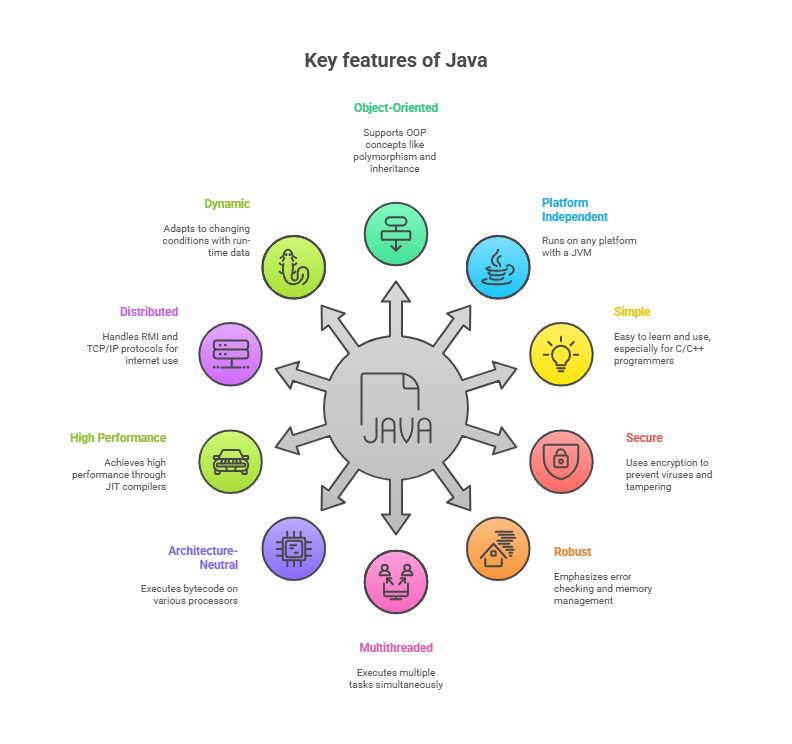Java in Simple Words
Since its original release in 1995, Java a high-level, general-purpose, object-oriented programming language has seen extensive adoption. Windows, macOS, and various UNIX versions are among the many systems on which it runs. Java is famous for allowing programmers to “Write Once, Run Anywhere” (WORA), which means that code that has been compiled using Java can run on any platform that supports Java without requiring recompilation.
Key features of Java

- Object-Oriented: Because Java is based on an object model and is entirely object-oriented, it is readily expandable. Polymorphism, inheritance, encapsulation, and abstraction are among the OOP concepts that it supports.
- Platform Independent: The Java Virtual Machine (JVM) on the particular platform on which a Java program is running interprets the platform-neutral bytecode that has been compiled from Java programs.
- Simple: Java is made to be easy to learn, especially for programmers who are accustomed to using C or C++ syntax. Complex features like pointers and explicit memory allocation are eliminated.
- Secure: Public-key encryption-based authentication in Java encourages systems free from viruses and tampering. In order to prevent unwanted access, it offers a virtual firewall between the computer and apps.
- Robust: Places a strong emphasis on error checking at compilation and runtime, with automatic garbage collection for memory management and object-oriented exception handling.
- Multithreaded: Enables the execution of multiple tasks at once, enabling interactive programs to run smoothly.
- Architecture-Neutral: In the presence of a Java runtime system, the bytecode can be executed on a wide range of processors.
- Interpreted and High Performance: High performance and interpretation are made possible by Just-In-Time (JIT) compilers, which translate bytecode to native machine instructions in real time.
- Distributed: Designed to handle Remote Method Invocation (RMI) and TCP/IP protocols in the dispersed environment of the internet.
- Dynamic: Adapts to changing conditions and contains a wealth of run-time data for resolving and verifying object access.
History of Java
James Gosling launched Sun Microsystems, Inc.’s Java language project in June 1991. Java was originally driven by the requirement for a platform-independent language to develop software for embedded consumer electronics such as remote controls, microwave ovens, and toasters, not the Internet. Compilers for the majority of computer languages at the time had to be created specifically for each CPU, which was costly and time-consuming.
The original name of the language was “Oak,” after an oak tree outside Gosling’s workplace. It was called “Green” as well. The Java coffee bean inspired the 1995 renaming, which was “Java,” which was selected from a list of random phrases.
As Java’s specifics were being worked out, the World Wide Web started to become more popular, which led to a big need for portable software. Java’s focus shifted from consumer electronics to Internet programming as a result of this.
With Java 1.0, the first public implementation, Sun promised “Write Once, Run Anywhere” (WORA) and free run-times on widely used platforms in 1995. Java was popular with the many seasoned C/C++ programmers because of its object model, which was modified from C++, and its syntax, which was primarily inherited from C.
By the development of bytecode, an efficient set of instructions run by the Java Virtual Machine (JVM), Java’s portability and security issues were resolved. Regardless of the underlying hardware or operating system, this intermediary representation guarantees that Java programs can execute on any system with a JVM.
A large portion of Java was made available as free and open-source software by Sun under the GNU General Public License (GPL) on November 13, 2006, and the process was finished on May 8, 2007.
Java became the property of Oracle Corporation after it purchased Sun Microsystems at the beginning of 2010. Under Oracle’s leadership, Java has developed further. For example, Java SE 7, which included new language and API capabilities, was the first significant release following the acquisition. The Java Tutorial’s Sixth Edition incorporates Java SE 8, which included important features like lambda expressions, increasing the expressiveness of the language and influencing the way Java code is written. Java’s adaptability and ongoing significance in the computing industry are highlighted by its ongoing development.
